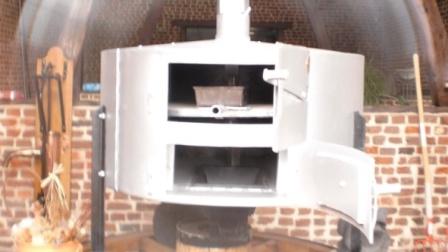 To make bread you mix the ingredients, knead thoroughly, let rise, weight pieces, knead again and shape the loafs. Let those in shape or baking tray, bake 35 to 45 minutes (depending on size) at 250 to 280 degrees C.
To make bread you mix the ingredients, knead thoroughly, let rise, weight pieces, knead again and shape the loafs. Let those in shape or baking tray, bake 35 to 45 minutes (depending on size) at 250 to 280 degrees C.
We used to be baked once a week. Breads were kept in a large kettle with lid, so they did not dry out too much. (Nowadays after 1 day it’s called old bread!) Food waste is sin, and stale bread is reused throughout the world in dishes.
Old (stale) bread
You can grill slices (toast), and even use the biscuits for snacks reception.
Dried or toasted sandwiches you can (with or without crust) crumble (e.g. with a rolling pin or bottle) and use as breadcrumbs to meat croquettes i.e. to coat food after a bath in foamy beaten egg whites.
Use slides for croque monsieur, or pizza crust with spaghetti sauce and cheese.
Spaniards use stale bread to make gazpacho (cold soup) thicker
You can handle it in bread pudding with raisins.
Baked crusts (croutons) are delicious in soups, in salads.
Slices bathed in beaten egg (with milk) and then baked we call lost bread, won bread or (French) toast. With some sugar they taste like pancakes.
The Danes soak them rather with some beer.
And the pain perdu of the Spaniards called torrejas, with caramel and sugar water, red wine and herbs (fennel seeds, star anise, nutmeg, vanilla beans, orange peel, cloves). After soaking the slices pass trough flour and beaten egg before they slide into the pan with olive oil.
The staling of bread begins when it comes out of the oven. There are already piles of voluminous studies on. Describing sets of complex molecular processes and the development of other structures. The crumb is downer, harder and drier, less elastic, the crust is softer by about recrystallization and redistribution of water. To this change of texture is not much to do. Do not keep bread in the fridge (preferably between 20 and 27°C, or freeze it).
Heating above 60-80°C can make it more tender again (but afterwards it ages faster.)
(The industry uses enzyme and / or emulsifying agents which slow down the process. )
The in 1991 found Alpine mummy Otzi had in his 5,300 year old stomach bread of einkorn. The grain was milled and baked. Charcoal traces showed that under the electron microscope. (This also shows that he lived in a farming community.)
The oldest (flat) bread -14,400 years old- was found in a campfire under the sand of the Black Desert, in the northeast of Jordan. It was made by the Natufians, people who lived in settlements in the Levant before the emergence of agriculture (about ten thousand years ago). It is more than four thousand years older than the origin of agriculture. The baking of bread would have encouraged hunter-gatherers to grow crops and live near the fields. Some wild grains could be identified as the ancestors of domesticated barley, oats and unicorn.
Edible paper
Edible paper is a very thin layer of unleavened baked starch used as anti-stick coating for biscuits (macaroons). Edible paper is gluten-free because it is made of potato starch (92%), water (7%) and vegetable oil (1%). (In the east of rice starch.) For Eucharist pure wheat flour is used.
"The new import and foreign kock", Part I and II, Issue A. van Goor, Nijmegen, 18th century
One takes them to the best and fynest Flour that one can have, stirred it with cold water that is not too thin and not too thick and styf am, then in a smooth sheet-waffre-iron cooked fried, that they are white and beautiful; One should the iron let be both zyden first good warm or hot, smear with a piece of bacon, and then re-clean, so cook it thoroughly.
Baking paper is treated in sulfuric acid or zinc chloride and degreased paper coated with a silicone coating.
After drying, it is light, and temperature resistant. There is (according to the producer) also fully compostable FSC unbleached parchment paper with a silicone layer.
See also <Baking bread > at <Fire>
‘If you eat brown bread you will never die, or at any rate you will live until everybody is tired of you.’ (AG Gardiner)
‘Man does not live by bread alone. Also by the cheese between another man’s bread.’ (Julien De Valckenaere)
Pasta
To make good pasta, the flour (or meal) should contain many gluten.
Mix 500 grams of wheat flour (for pasta) with 1 teaspoon salt. Do herein 4 eggs and 2 tablespoons olive oil. Knead good and long until you get an elastic ball. If necessary, add some flour or water. Let rest covered for half an hour. Roll (with flour) into thin slices. The lasagna or ravioli.... is ready.
Let him dry several hours to 1 day. Then the pasta gets a longer cooking time and is less likely to overcook. The cooking time of non-dried fresh pasta is about 1/2 to 1 minute. The cooking time of dried, fresh pasta is from 2 to 5 minutes, depending on thickness, and drying time.
Don’t store homemade dried pasta too long, there are raw eggs in and the oil becomes rancid.
Macaroni : inventor of the telegraph with wire. (Guy Mortier)
Spaghetti tastes like macaroni, but a little longer.
